50th General Hospital Unit History

Left: Colonel Rollo P. Bourbon: Commanding Officer, 50th General Hospital.
Right: Lieutenant Colonel Hubbard T. Buckner: Executive Officer, 50th General Hospital.
Activation & Training:
The 50th General Hospital was officially activated on 4 September 1942 under the command of Colonel Rollo P. Bourbon, with Lt. Colonel Hubbard T. Buckner being assigned as Executive Officer. However, discussions had been ongoing about forming a unit under their command since 1940, and recruitment had begun long before this date. Buckner had previously served with Base Hospital No. 50 during WWI, and under the sponsorship of Seattle College, Washington, organized the unit once again from the same locality. The 50th was officially activated as a numbered General Hospital, and thus Officers Buckner and Bourbon had the duty of finding sufficient staff to satisfy T/O 8-550. At the time the organization consisted of 65 Medical Officers – 110 Nurses – 2 Hospital Dietitians – 2 Physical Therapy Aides – 5 American Red Cross Workers – and 500 Enlisted Men.
Although the vast majority of the unit’s doctors were taken from local volunteer practitioners, determined to enter the service following Pearl Harbor, and who could see the advantages of a fixed General Hospital in which they could practice their specialties with fellow colleagues and friends. However, the recruitment of the large number of Nurses required (105) proved difficult, but by enlisting personnel from almost every hospital in the state of Seattle, Dr. Buckner was able to complete the unit’s roster.
Recruitment continued during the spring and summer of 1942, with the unit orders finally being received. Officers of the unit were due to leave for Camp Carson, Colorado Springs, Colorado (Division Camp –ed) by train on 1 September 1942, with the Nurses departing 10 days later for the same destination. Most of the men aboard the train held a naïve attitude, expecting to return to Seattle in time for Christmas. With the exception of 4 Officers (Lt. Colonel Hubbard T. Buckner – Major John W. McDowell – Major Charles Q. North – Captain Walter J. Fry), none of the service personnel had seen previous service with the US Army. The camp was large and overlooked by the imposing figure of the Cheyenne Mountain. During the unit’s time at Cp. Carson, the Medical (or western) section of the area housed two General Hospitals, two or more each of Field and Evacuation Hospitals, in addition to the fixed Station Hospital personnel.
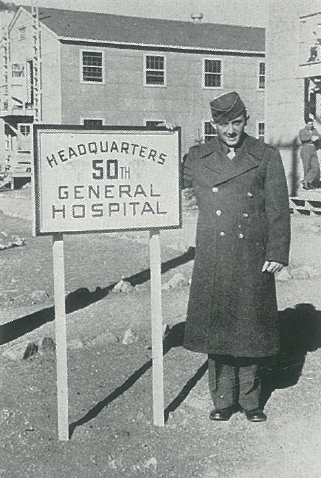
Technician 5th Grade Donald L’Huillier stands in front of the unit’s Headquarters sign.
The stay at Cp. Carson proved to be lengthy, sixteen months in total. Dr. Buckner knew that he wanted the 50th Gen Hosp to perform as well, if not better than Dr. Eagleson’s Base Hospital No. 50 had during the previous conflict. This meant that the training was lengthy and thorough. Calisthenics were used for physical toughening, and gradually lengthening hikes ensured that physical and military conditioning could be both orderly and complete. Another major advantage of the long training at Cp. Carson was the fact that it allowed for the selection of the most promising five hundred of the 1,000 Enlisted Men who had been assigned to the unit. The majority of the EM had finished their MTP 8-10 in February and March 1943. From this time, they were assigned duties in the Station Hospital, with continual refresher courses being offered.
In addition to being assigned to the Station Hospital throughout the year of 1943, continual work was done to ensure all members of the roster were reminded of the subjects covered in MTP 8-10 (Mobilization Training Program –ed). The table below shows the numerous subjects covered, and the amount of time (in hours) each member spent on the discipline:
| Hospital Experience | 825 |
| Physical Training | 106 |
| Drill | 78 |
| Hikes | 113 |
| Defense Against Mechanized Attack | 4 |
| Sanitation | 11 |
| Litter Drill | 4 |
| Set Up General Hospital | 30 |
| Bivouac (4 nights) | 48 |
| Tent Pitching | 41 |
| Chemical Warfare | 6 |
| Inspections | 44 |
| Military Courtesy | 1 |
| Tropical Medicine | 42 |
| Dietetics | 4 |
| Ward Procedure | 85 |
| Ward Management | 26 |
| Orientation | 37 |
| Medical Lectures | 12 |
| Nursing Lectures | 12 |
Although the provisions for the unit’s training were far superior to those available in 1942, it was still necessary for the staff to use initiative for certain items. For example, the T/E did not authorize water tanks or mallets – the latter being essential for pitching large Hospital Ward Tents. Following the instruction of Col. Bourdon, the organization’s carpenters produced 100 mallets by cutting down nearby trees and shaping handles and heads. Water tanks were provided only by borrowing from other units, and never in sufficient quantity for the unit’s bivouac. The 50th Gen Hosp was probably one of the first General Hospitals in the Zone of Interior to go on hikes and bivouacs. It was felt that this was a necessity in view of going on overseas duty. The bivouacs gradually extended from a single night to 4 nights (duration 5 days), during which field problems were handled, calisthenics held, and hikes practiced. The latter went from a basic 2 miles up to 14 miles on a single day. Latrine and rest stops were held for approximately 10 to 15 minutes, and meals consumed in the field in mess kits. Sometimes, fires were lit at night and men and women sang familiar songs. Another most interesting and memorable experience was the infiltration course, accompanied by live fire, and the gas chamber test.
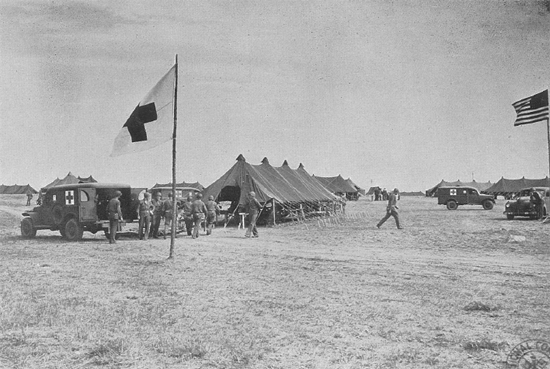
Personnel of the 50th General Hospital unload an ambulatory patient during a training exercise in the ZI.
Monthly inspections for VD were carried out at Cp. Carson, with sex hygiene lectures being given twice during 1943 to all Enlisted Men of the unit. A prophylactic station was also maintained at the area infirmary, and at no time did the unit’s venereal rate give cause for concern.
It was during the prolonged period at Cp. Carson that permitted the acceptance of musical instruments from Bing Crosby with which to form a unit orchestra. Both Bourbon and Buckner appreciated the necessity for musical relief within the unit. It was realized that along with medically-skilled personnel the unit’s members also comprised of a number of highly talented musicians. With Tec 5 David Koch having been appointed as Band Leader, the orchestra was comprised as follows:
| Trumpets | Pfc. Carl V. Will Pfc. Donal H. Coleman Pfc. John N. M. I. Piacitelli T/5 David L. Montgomery |
Clarinet | T/5 John B. Payette T/4 Gorman D. Brandley T/4 Stanford Raleigh |
| Trombones | T/5 Frank A. Guyer T/5 Henning A. Jurgens Sgt. Arthur E. Brothers |
Saxophone | T/5 Frank L. Herndon |
| French Horn | T/4 Richard S. Larson | Piccolo | T/5 Lysle M. Bach |
| Baritone | T/3 Daniel H. Wiltfang | Snare Drums | Pfc. Joseph A LaPlante Pfc. Paul R. Carlin T/5 Edward B. Ferris |
| Tuba | T/5 Willard A. Wiltse | Brass Drum | T/4 Walter B. Firman |
| Cymbals | Sgt. Vincent Kowalski |

The unit’s band.
One evening in January 1943, a hurricane swept through the camp for twenty-four hours. The strong winds had caused a power cut in the barracks, and all of the Nursing staff was returned to their barracks (or wards for those currently on night duty) by ambulance. All personnel were instructed to lie, fully clothed and wearing money belts containing all valuable possessions on top of their cot. Resourcefulness of the Hospital staff was taxed that night; flashlights were used for illumination; sterilization was done using cold water. Although not part of the scheduled training plan, the event did prove to be good experience for blackout maneuvers.
Throughout the 50th’s stay at Cp. Carson, the Table of Organization (T/O) experienced frequent changes. This necessitated the transferring out of good, well-trained Hospital personnel, many of whom had made good friends with their comrades and colleagues of the command. Only four of the original Officers at Cp. Carson remained with the unit during its movement overseas and into the ETO. There was difficulty in maintaining the T/O at the prescribed numbers. Frequently, Nurses would be sent on TD, and the following is an illustration of the various assignments to which the Nurses of the unit were sent:
| Jefferson Barracks | 20 | Camp Phillips, Salinas, Kansas | 12 |
| Camp Salinas, Kansas | 25 | PW Camp, Trinidad | 3 |
| Air Force Flying School Garden City, Kansas | 7 | Winter General Hospital | 30 |
| PW Camp, Trinidad | 5 | O’Reilly General Hospital, Springfield, MO | 30 |
| Winter General Hospital Topeka | 30 |
A Field Hospital was set up, occupying existing buildings of Theater of Operations-type construction, with the Detachment in bivouac. This Hospital functioned for one day, receiving, treating and disposing of ‘simulated’ patients. All departments were active and gained experience in operating under field conditions. In addition to this, an entire, functioning General Hospital under tentage was established. In total, 264 tents (including 60 ward tents) were necessary for the unit, and the Hospital was made ready to function in 2 days, with no work being carried out at night. This particular establishment was inspected by President Franklin D. Roosevelt on 22 April 1943 – a highlight for all Officers, Nurses and Enlisted Men of the 50th General Hospital.
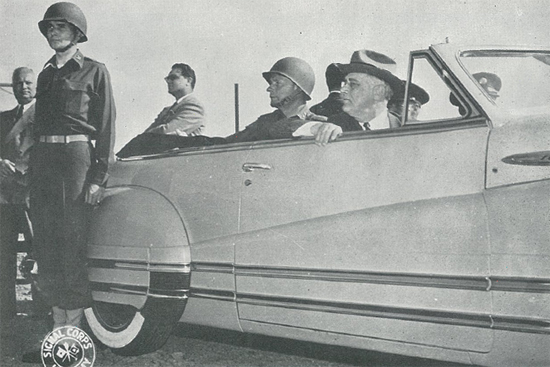
Inspection of the 50th General Hospital by President Roosevelt on 22 April 1943.
Movement to the United Kingdom:
The unit left Cp. Carson on 16 December 1943, aboard two complete troop trains. The trains arrived at Camp Myles Standish, Boston, Massachusetts (Staging Area for Boston Port of Embarkation –ed) on 19 December 1943, only a matter of hours apart despite having different routes. The time spent here was used for additional training, briefing and issue of the necessary equipment and immunization. On 28 December 1943, the organization proceeded by train to the Boston Port of Embarkation, and boarded the troop ship Edmund B. Alexander the same day. The unit set sail the following day (29 December 1943) as part of a larger convoy also carrying the 1st General Hospital and the 16th General Hospital. The journey itself was uneventful, filled with sleeping, reading, playing cards, drills, salt water showers, and KP for those without luck. No one was allowed on deck after dark as blackout conditions prevailed.
Debarkation took place at Liverpool, England on 8 January 1944, being greeted by ARC ladies serving hot coffee and donuts. Following assembly, the entire group then entrained for their next destination, being treated to gum and cigarettes and more coffee and sandwiches on the way, with the unit arriving at Oulton Park, Cheshire the same day (where the advance party was already installed).
The period spent at Oulton Park was cold and damp. Buildings were fabricated, one-story temporary constructions scattered over a large area. It was here that the Headquarters received copies of circulars, bulletins and memorandums published by the European Theater of Operations, Communications Zone, Chief Surgeon and Western Base Section. Recreation consisted of truck convoys (for those on pass) to the town of Chester, each night. Activities on the Post itself were rather limited, and so improvised sports matches were organized, as no equipment of this type had arrived. Picture shows and USO entertainment were available at the 360th Engineer General Service Regiment’s improvised show house. In addition, a unit dance was enjoyed by approximately 80% of the unit at the camp, with dancing partners coming from the civilian population of the surrounding area.
Movement to Glasgow, Scotland:
On 18 January 1944 an advance party left Oulton Park by train and arrived in Glasgow, Scotland later the same evening. It was met by trucks and transported to Cowglen Hospital, at Boydstone, on the outskirts of Glasgow. Cowglen was in the 26th District of the Western Base Section. The advance party acquainted itself with the functioning of the Hospital, signed for equipment and the Commanding Officer assumed command from the 2d Evacuation Hospital on 2 February 1944. On 17 February, the remainder of the unit arrived at the complex.
The facility provided excellent location for bivouacking a unit, being situated adjacent to two golf courses. In addition, rail facilities were only a short distance away with several bus services running regularly approximately 200 yards from the front gate of the Hospital. New Nissen Hut-type buildings had been built and more were under construction by the British at the time of the unit’s departure in July 1944. The Hospital was connected to the city’s sewerage system as well as the city water system, both of which proved excellent amenities for the facility.

Field inspection of the 50th General Hospital.
The first medical equipment and supplies were taken over from the 2d Evac Hosp (which functioned as a 750-bed unit). Thereafter, supplies were transported by rail from Medical Depots to Cowglen. Distances to the Depots were too great for trucks to make trips and therefore many supplies were acquired from the British. Cleaning and preserving products and office stores were supplemented by requisition from the British barracks located nearby. All medical gases were obtained from the British Oxygen Company located in Glasgow. At one time supplies of blankets, litters, pillow cases and sheets used in evacuation of patients by air were transported by air to Prestwick Field, which was located close by. The Medical Supply Department occupied two large Nissen huts and the space proved ideal.
The first visitors to the Hospital’s complex at Cowglen were three professors and twenty-one students from the Glasgow Medical College. The visit was short and uneventful, but most of the students claimed it had been invaluable to their course. This was in contrast to the visit of two, sharp-tongued, sharp-eyed Generals on 18 January. Generals George S. Patton, Jr. (TUSA) and John C. H. Lee (SOS) were both visiting the Hospital, and despite many hours of additional work, both men were able to discover items (contraband, uneaten food in garbage) that would severely dent the unit’s complacency. However, numerous lectures and seminars by the two Generals proved to be invaluable learning aids for the unit’s journey overseas!
As of 2 February 1944, Cowglen became the first Hospital complex to be run independently by the 50th organization. Interest was heightened by the few instances of DS to which some of the members were ordered after the unit took control of the Hospital. The stay at Cowglen was lengthy, and a steady stream of patients was received. The advance detachment of the 50th GH received orders to relocate to Crookston on 2 July 1944. In the days which followed, the remaining Hospital personnel turned the facility at Cowglen over to the 112th General Hospital.
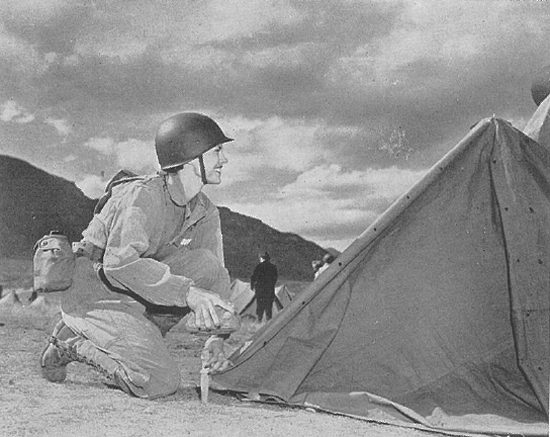
2d Lt. Narita N. Chambers erects a shelter tent at one of the unit’s locations.
For the first several months, patients were received from Army transports debarking at Greenock and arriving from the United States and as a result the Hospital had a predominance of acute diseases. For example, the total number of medical cases in April 1944 was approximately 1,200. Among great variety of acute diseases, there were 38 cases of measles, 54 cases of mumps, 42 cases of pneumonia, 65 cases of syphilis and 48 cases of gonorrhea. The cases arriving from the boats were very sick, especially with pneumonia. Approximately 20% of the cases of pneumonia were of the lobar type. Temperatures were high, the patients were extremely toxic and several seemed resistant to adequate dosage of sulfonamides. These cases were however treated successfully with penicillin.
On 20 June 1944, Brigadier Stevenson, Medical Consultant for the Scottish Command, visited and inspected the Medical Service. Inspections were made regularly by Officers of the 26th District, Western Base Section, and occasionally by representatives of the Chief Surgeon’s Office. Special inspections were made by General Lee, General Patton, General Kirk, General Grant, General Manifold, Surgeon of the Scottish Command, Brigadier Sheppard and others.
Movement to France:
On 3 July 1944 the unit moved from the Cowglen Hospital to Crookston Camp, which proved to be a staging area and was approximately six miles away. The complete move was effected on 7 July 1944 and the Hospital plant turned over to the 112th General Hospital. Orders were received on 9 July 1944 to leave Crookston, and the truck convoy left on 10 July. The following day, the train containing the balance of the organization left Scotland at 0130 hours, with the Nurses detraining at Plymouth, England and the remainder of the personnel at Truro at 2000 hours.
Preparations were then made for the journey across the Channel. A group of Officers and Enlisted Men were sent to Plymouth to assist and accompany the Nurses, who first boarded an LCT and eventually transferred onto a British Hospital Ship travelling together with the 298th General Hospital and a group of infantry landing in France on the Utah beachhead 16 July 1944. Each member of the unit, having waded ashore and tackled the sand dunes then marched seven and a half miles through unshaded country on the hottest day of 1944! Passing through St-Martin-de-Vareville and St.-Germain-de-Vareville, the unit eventually arrived at the Transit Troop Area “B”, where it set up bivouac for the night. The following morning, a truck convoy arrived to transport the personnel and its equipment to a camp site just east of Carentan. At this stage, the unit was still without Nurses, but theirs is an entirely different story (they received orders to board trucks and ambulances to take them into Cherbourg, France –ed).
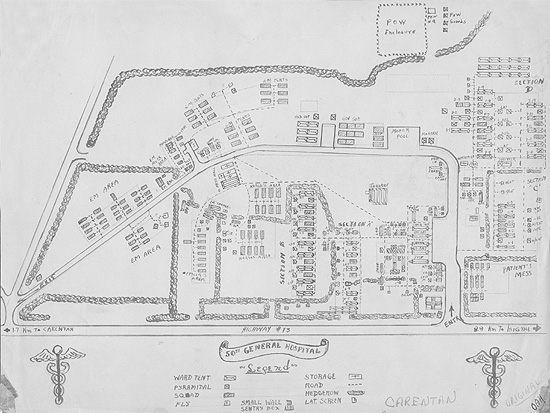
Illustration showing the tented facility established by the 50th General Hospital in a field near Carentan, France.
The remainder of the personnel of the 50th left for Falmouth by way of truck, and boarded the Liberty Ship James B. Weaver at 1200 hours. On 17 July the organization went over the side to board an LCT which unloaded its passengers on Utah Beach, Number 8, at 1300 hours. A march for approximately 7 miles was made from the beachhead through Ste. Marie-du-Mont, to an area in the vicinity of Boutteville. The Nurses covered the same route and from the Transit Area went on by motor convoy to Cherbourg, France. The EM spent a single night at the Transit Area “B” and on the following day moved by trucks to a bivouac area on the outskirts of Carentan, on the Carentan-Isigny highway, where the Nurses later joined the group on 20 July 1944.
During the Carentan bivouac period, surgical and medical shock teams, together with groups of Nurses and Enlisted Men were sent on DS to various Field and Evacuation Hospitals near the front. An Orthopedic Team, consisting of the command’s Chief of Section, 1 assistant-Surgeon, 2 Surgical Technicians, 1 Surgical Nurse, and 1 Nurse-Anesthetist, worked in the 41st Evacuation Hospital for a period of three weeks, during the attack against Saint-Lô, France. On 28 July, an Engineering unit began work on the first phase of a 1,000-bed tent hospital a short distance across the road from the bivouac area. All personnel assisted the Engineers during the building period, and on 13 August 1944 the first tent was set up at 1400 hours. The following day, twenty patients arrived at 1800 hours. The Hospital was officially opened at 0001 hours with 400 beds on 15 August 1944. By 26 August, the 50th General Hospital had been expanded to a 1,000-bed capacity unit. The orthopedic work continued to be heavy and diversified. Many injuries were caused by booby traps and mines, and included numerous serious automobile accidents involving military as well as civilian personnel. Quite a large number of German PW patients with combat wounds of the extremities and bones were also treated. Although being a 1,000-bed installation, the Hospital in barely three months, treated 1,206 casualties with bone and joint injuries, answered 820 orthopedic consultations, and treated 175 outpatients with similar condition.
The 207th Quartermaster Laundry Platoon, type B, was assigned to the 50th General Hospital to handle the laundry of the command. Its site was approximately five miles from the Hospital and because of distance and breakdowns, the laundry was continually operating under a handicap. Later, the Platoon was reorganized into two laundry sections, the 207th and 306th but continued to operate as one.
On 17 September 1944, a group of 250 PWs were obtained from the Normandy Base Section PW Enclosures, to be used as labor in and around the Hospital at Carentan. These prisoners were a group of well-disciplined and hard-working Germans. They were members of a Fallschirmjäger Division captured at Brest. The guard personnel included 1 Officer, 1 Chief Warrant Officer and 35 Enlisted Men. The prisoners worked in the following departments and on the following details:
| Ward A | Motor Pool |
| Ward B | Quartermaster |
| Ward C | Medical Supply |
| Ward D | Patients’ Mess |
| X-Ray | Detachment Mess |
| Shock Ward | Road Maintenance |
| Dispensary | Landscaping Unit |
| Orthopedic | Wood Cutting Unit |
| Central Supply | Tent Maintenance Unit |
| Surgery | Sanitation Unit |
| Emergency Litter Bearers | Coal Unit |
The PWs were turned over to the 180th General Hospital on 16 November 1944 after having been trained by each department for a specific job. During this period with the 50th, there were no escapes, accidents or deaths among the prisoners.
During the first month while the unit was bivouacked, the main recreation consisted of playing softball. Many good games were played which offered enjoyment to all. On an average of four days out of the week, the band held band practice. This offered a source of music entertainment, and the Special Service also made books available to all. Upon moving to the Hospital site, 4 ward tents and 1 storage tent were laced together, making a large show tent capable of seating 500 people. A stage with footlights and dressing room made this a complete theater house where USO shows and motion pictures were given. Five USO units played before a total crowd of 5,000, showing one show for the patients in the afternoon and one in the evening for the Hospital personnel. Motion pictures were shown six afternoons and evenings of the week, with a new picture every other day. Average attendance was 450 at each showing. Two interlaced ward tents were set up to form a Day Room for the men. Later, a prefabricated hut was constructed for the use of the Detachment. An Officers’ and Nurses’ Club Room was built, using ward tents with the addition of a brick fireplace in one end of the two tents.
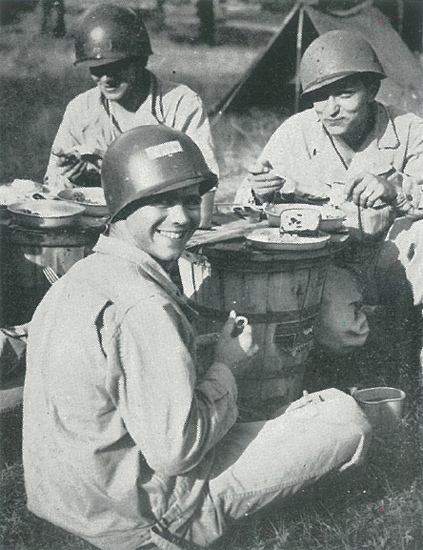
Pvts. Charles A. Wilson, John R. Capaccio with T/5 Bernard L. Fulk enjoy rations in the field.
At the Carentan complex, the Hospital received patients from local military organizations, Port Battalions, Engineers, etc., and by Hospital Train from advanced hospital echelons. The Medical Service used 19 wards of 30 beds each, constructed on a cement slab floor and a tent overhead. In addition it operated an Outpatient Dispensary which attended to a total number of 12,055 patients. Officers, Prisoners of War and Venereal Disease Sections had the largest number of patients.
Mosquitoes proved very troublesome especially during July and August. The fields and hedgerows contained many shaded pools filled with stagnant water which were an ideal spot for the breeding of mosquitoes. These mosquitoes were identified as both of the culex and anopheles species. It is believed that two cases of malaria had been contracted in Normandy. As many pools as possible were oiled and all malaria patients were kept carefully screened.
Through September, October and November 1944, an increasing number of combat exhaustion cases were seen. These men had been assigned to the 90th Quartermaster Company for “Labor Battalion” work directly from the field exhaustion centers. At first this program seemed ideal as most of the patients were anxious to work, their services were needed and helped to overcome the emergency shortage of manpower and hospital beds. However, as time went on it became apparent that some of the men had been too ill to work. A certain idea of “punishment” behind the project also detracted from the value there obviously was in the program of useful work.
As fall of 1944 arrived, duck-board walks were established between the tents, since the weather had become rather cold and rainy. Even in shelter from the rain, the cold temperature proved to be a problem. A small single stove and a minimal amount of coal was supplied for each pyramidal tent. One of the Officers’ tents had a large stovepipe coming from its provided opening, which one evening became red hot to the point that it ignited the canvas! It took heroic efforts to save personal possessions from the tent, and the incident certainly kept the administrative typewriters busy!
Extra cement and brick for floors and fireplaces was found, and so the construction of two clubhouses began, one for Officers and one for Enlisted personnel. These ‘buildings’ were constructed in the same manner as the Mess Hall, each using three ward tents laced to one another, and placed over a concrete floor. They offered a relatively warm place for informal gatherings; games of bridge, a phonograph and occasionally a dance, with music being provided by the 50th’s own Band.

Members of the 50th’s X-Ray Department inspect equipment.
L to R: Pvt. Charles J. Pascal; T/5 Raymond A. Knopf; T/4 Joseph J. Abel.
By the end of September 1944, it became necessary for the unit to establish an Emergency Ward. Since the Hospital’s complex was directly opposite the “Red Ball Express” route through Normandy, and because of the local inhabitants’ interest in military vehicles, an increasing number of admissions were made relating to vehicle injuries. The purpose of the emergency ward was to offer essential care and treatment for these casualties, and hold them until arrangements could be made for them to stay with a local neighbor or friend. As the fighting moved further to the east of the country, and towards Paris, the Hospital saw fewer combat casualties and an increase in civilian and PW admissions.
On 4 November 1944, an advance detachment left for its new location at Commercy, France. The site was to be a group of buildings of an old French Cavalry Post, known locally as the ‘Caserne Oudinot’. It was excellent as to drainage, storage and buildings, but required a tremendous amount of engineering to install plumbing, heating and lighting, and in general to adapt a Cavalry Post to the requirements of a complete Hospital. In the meantime, another Orthopedic Team was constituted and placed on DS at Morhange with the 30th Field Hospital. This was mainly in support of armored units. Many of the patients treated at Morhange suffered severe and mutilating injuries. On 18 November the remainder of the organization left Carentan by way of an Hospital Train, and the plant there was turned over to the 180th General Hospital. During the initial period of construction at the new installation, surgical and medical shock teams with other groups of Nurses were again sent on DS to Field and Evacuation Hospitals. On 4 December 1944, the Hospital officially opened as of 0001 hours, with a capacity of only 400 beds. On 10 December the bed capacity was raised to 600. 1,300 beds were available by 21 December, and on 30 December 1944, 1,400 beds were reported ready.
The first large admission recorded on 18 December 1944, consisted of 304 Soviet-Russian and Italian PW patients evacuated from a German TBC Hospital, and captured by Third United States Army troops (all had previously served in the Wehrmacht –ed) . All showed extreme degrees of malnutrition and overall poor condition including many cases of nutritional edema and pellagra. Most of the cases suffered advanced tuberculosis, both pulmonary and extra pulmonary, but some few showed only malnutrition; Many of the prisoners would become fatalities because of the severe injuries of the knees, hips, and spine, alone or in combination, with other wounds or injuries. The month of December also brought a flood of combat exhaustion cases. Again, as in Normandy, there was an increase during periods of stalemate or enemy counter-attacks. The morale of the men seemed good and very little, if any, malingering was suspected.
At Commercy, the X-Ray Department had adequate room. Wall thickness and barium plaster ensured that there would be no problem of secondary radiation. Both the darkroom and the fluroscopy room were made with labyrinths. The design and most of the actual construction was done by the men of the department. Regular field equipment was used for this purpose. The surgery facilities were located on the first floor of the complex.
The following statistics represent a brief summary of the dispositions of the 50th General Hospital through 31 December 1944:
| To Duty | 6470 | or | 53.8% |
| To Rear Echelon | 3384 | or | 28.3% |
| To Hospital Same Echelon | 1699 | or | 14.6% |
| By AWOL | 8 | or | 0.1% |
| By Death | 60 | or | 0.2% |
| 11621 | 100% |
On 23 January 1945, the first group of personnel left the Hospital for Reinforcement Depots and shortly thereafter a corresponding number of combat troops on Limited Assignment arrived as replacements. This continued during the next three months and worked out without detriment to the Hospital service inasmuch as trained Technicians were not ordered out. By 1 February 1945 1,700 beds were available for patients.
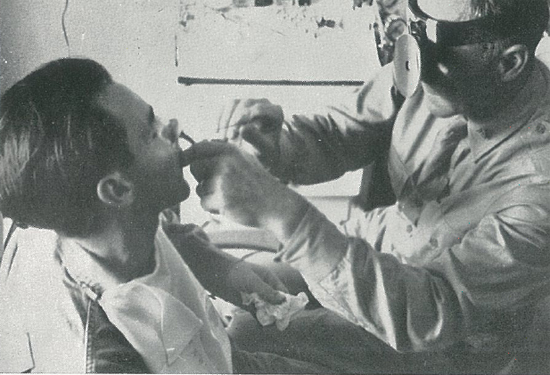
Examination and treatment of nose injuries on a patient by Major Charles Q. North.
There was much snow and cold weather during the month of January. During this time, 3,000 refugee Alsatians arrived in Commercy from the border towns around Bitche whose recapture by the Germans was threatened momentarily. The Hospital contributed some food but the major burden was carried by the French.
Although the Officers’ quarters had central heating and internal plumbing, the showers, located fifty feet away, were scheduled for all on the Post. The Nurses were lodged in a larger building diagonally across the Post. This caused a degree of upset and grumbling amongst Enlisted personnel, who were stationed in even less substantial buildings. Work on the complex was finally completed to a satisfactory level on 4 December 1944, which allowed the Hospital to open later that day with a capacity of 400 patients. By 10 December, this was increased to 600 beds, and by 21 December, the unit was reported as having an official capacity of 1,300 beds.
During the months of December, January and February, an extra security Officer of the Day was assigned. Polish soldiers had been assigned to this duty despite the considerable language barrier. There was slight concern amongst the Hospital personnel since the Polish troops were rather eager to be issued with American M1 Rifles, and many were sceptic with regard to the protection of the German PW patients under treatment at the Hospital.
The use of PW and civilian help throughout the beginning of 1945 meant that further expansion of the complex was possible, resulting in 2,300 beds finally being established by April. The 400 German PWs that had been working at the installation were used for kitchen police, dishwashing and for carrying litters to the third and fourth floors in the ward buildings. Their quarters were makeshift, but more than adequate. Discipline was not a problem, since many of the German NCOs resumed their role and applied military courtesy to the units.
The families of the Polish security force ran a small vegetable farm on the Hospital complex for the staff, but in an effort to support the French economy, the staff was instructed to hire a total of 150 French women to assist with tasks around the Hospital. Their pre-employment physical examination was primarily a testing for tuberculosis, lues, pyuria and skin filth. Although their work was slow, and Hospital staff were appointed as foremen for the operations, the French women helped perform the laborious tasks in and around the Hospital complex.
The maximum number of patients received on any one day in 1945 was 455 on 3 April, corresponding to the Battle of the Rhine. Most of the patients were received from Hospital Trains, therefore, there was marked fluctuation in the census of patients admitted. On 26 December 1944, 525 American soldiers were received corresponding to the Battle of the Bulge. On 23 March 1945, there were 145 admitted; 24 March – 152; 25 March – 151; 26 March – 194; and 27 March – 180 were admitted to the Hospital. On 20 April 1945, 404 were admitted, which represented a large influx. The maximum bed capacity was reached 16 April 1945, with 2,370 beds reported and the maximum census reached 20 April 1945, with 2,188 beds occupied.
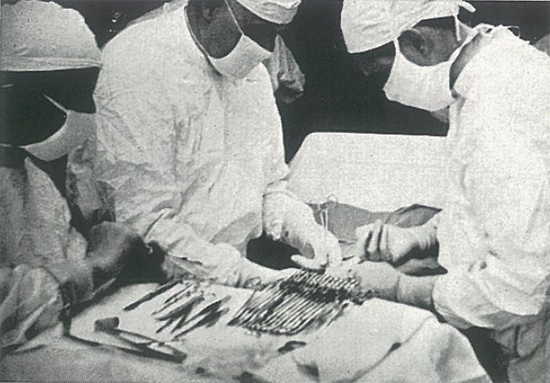
An operating team of the 50th General Hospital applies hemostats during surgery.
On 25 March 1945 the Hospital received its first change in command since the activation on 4 September 1942. Colonel R. P. Bourbon was transferred to the 95th General Hospital as Commanding Officer, and Lieutenant Colonel H. T. Buckner assumed command of the unit. During the month of April, many new Officers and Nurses were received; 8 MC Officers, 1 SnC Officer and 31 ANC Officers.
Christmas 1944 proved to be one of the 50th’s best Yuletides in the Army and also acted as a welcome relief from the tensions of the current situation. After a large unit meal in the mess hall on Christmas Eve, ‘the girls’ of the unit held open house and all toured their barracks, admiring the Christmas decorations that had been established, drinking all the while to their health! Despite the fact that they were away from home, morale was high within the close-knit bunch of comrades that had served in the 50th GH since its formation at Cp. Carson two and one-half years earlier.
The unit was not to remain together for much longer however. Combat-fit men from the Hospital organization were sent to combat Replacements Depots, and many of the company grade Officers were transferred out to Battalion and Regimental Aid Stations. In their place, the 50th received Enlisted Men and Officers from combat outfits, who needed the more protected environment of a General Hospital. Further changes were made to the overall organization, namely the transfer out of Colonel Rollo P. Bourbon to another numbered General Hospital and the resulting promotion of Colonel Hubbard T. Buckner to the position of Commanding Officer. Buckner selected Major John W. McDowell as his Executive Officer, a position which was approved by the entire staff of the unit.
By the end of January 1945, the staff had developed a routine procedure whereby patients could be admitted as rapidly as the ambulances could deliver them to the Admission shed, and as fast as the PWs could carry them to their ward assignments. It was during this period that the first admissions of Trench Foot were seen.

Preparing anesthesia for a patient at the 50th during a hydrocele operation.
During the unit’s time at Commercy, commissions for two Bronze Stars and a Purple Heart were awarded to members of the 50th, namely Major Kenneth E. Sherwood (0-473453), Lt. Colonel Hubbard T. Buckner (0-462241) and Major Philip H. Narodick respectively. Somewhat later, the unit as a whole was awarded the Meritorious Service Unit Plaque.
Victory in Europe:
The morning of V-E Day darned in much the usual manner as any other, with the staff reporting for their respective duties. The true significance of the day was first felt when as many as could be relieved from their work assembled at 0900 hours for the Victory Parade. The unit band led the formation, and was followed by the Officers’ Platoon, two Nurses’ Platoons, the Colors and Color Guard, six Platoons of Enlisted Men, and one Platoon of Rehabilitation patients. The procession passed down Commercy’s main street which was lined by locals and displaying the flags of the Allied Nations, and continued up to the town square where the reviewing stand was situated. The Commercy Firemen’s Band also joined the ranks.
After a short and impressive ceremony, the command “Pass in Review” was given. In time with the music, the Platoons wheeled out of the assembly area and marched around the square, passing first the monument commemorating the dead of WW1, and then the reviewing stand where stood the Commanding Officer, Chief Nurse and the leaders of the city of Commercy. Following the parade, the personnel returned to the post where there was still work to be done. But many activities had been planned to enliven the day, including a baseball game, a band concert and the formal opening of “Duffy’s Tavern” where American beer and Coca-Cola were on the house!
After V-E Day the influx of patients slowed appreciably until the census of the Hospital reached its lowest ebb during the first week of June 1945. The respite was short lived however, in that other hospital units on closing down transferred their patients. This brought the census up extremely rapidly and the unit was now as busy as it had ever been.

The 50th General Hospital orchestra preparing for V-E Day celebrations.
During the month of July 1945, the Hospital continued to be extremely busy inasmuch as the remaining hospitals in the 819th Hospital Center transferred their patients to it. Its census was augmented by patients from four Hospital Trains and by a steady though small influx from Field Hospitals in Verdun and Luxembourg City. However, the census fell steadily through July and August so that by the latter half of August two ward buildings, each capable of housing 240 patients, and 11 wards in other buildings could be closed without any overcrowding. This helped considerably because the staff had been dwindling gradually until it was inadequate to cover all stations. Most of the losses were sustained to units scheduled for redeployment in the Pacific Theater although several Officers and Nurses were transferred to the Zone of Interior because of compassionate leaves.
Return to the ZI & Deactivation:
On 21 August 1945, the unit was notified that it was to leave Commercy, France, in 6 days and report to the Staging Area, ‘Eagle Main and Rear’ at Verdun. This came as a complete surprise to most of the staff, since it had largely set itself psychologically to spend another winter in France. Then followed a busy week, preparing charts, packing, transferring property, including all small details incidental to transferring a Hospital Plant. This was completed at 0001 hours on 27 August 1945. Command of the area was turned over to Colonel H. I. Teperson of the 74th General Hospital. The Nurses left the area on 7 September, with the remainder of the unit leaving the following day.
On the move to Marseille, the Officers occupied third class French coaches, the Enlisted personnel had to do with the traditional “40 & 8” boxcars. The Nurses were reunited with the others for a short time at the Staging Area. After the usual checking of records, with transfers in and out, the unit was ready to leave for the United States. The Nurses, the Medical Administrative Officers and the Enlisted Men – plus all those newly transferred in – were assigned to the ship George Washington for transportation to the ZI. After mild confusion about its arrival time, all were loaded on 15 September 1945.
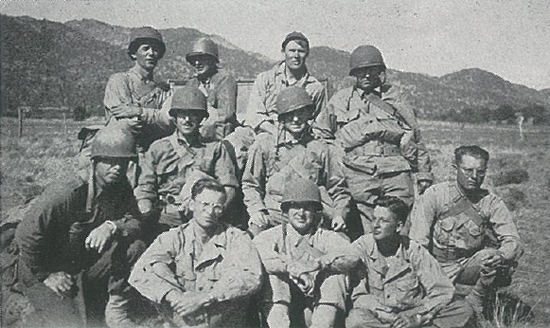
Platoon Leaders of the 50th General Hospital.
The unit was officially deactivated at Camp Kilmer, Stelton, New Jersey (Staging Area for New York Port of Embarkation –ed) on 26 October 1945. The Nurses had been flown to California from the east coast, and experienced problems with aircraft on the journey. While they were waiting in St. Louis for repair, the sergeant detailed to take care of the heavy records mislaid them. But eventually, after a 48 hour delay in California, all were discharged from the unit.
Statistics:
| To determine Physical Status | 249 (includes 198 lumbar punctures) |
| Allergic Diseases | 97 |
| Arthritis & Muscular Disease | 425 |
| Blood & Lymph Glands | 139 |
| Cardio-Renal-Vascular Disease | 186 |
| Communicable Diseases | 1331 (79 cases of Malaria) |
| Dental Cases | 87 |
| Dermatology | 509 |
| EENT | 1077 |
| Medical GI Disease | 925 |
| Surgical GI Disease | 393 (182 hemorrhoid cases) |
| Non-VD GU | 588 (only 92 in 1945) |
| Hernia | 96 |
| Metabolic Disease | 201 (164 malnutrition) |
| Misc. Minor Surgery | 737 |
| Nervous & Mental Disease | 1273 |
| Non-Fracture Orthopedics | 160 |
| Pulmonary Disease | 1094 (134 TBC) |
| VD | 812 (all but 47 in 1944) |
| Tumors | 103 |
| Chest Injury with Surgery | 7 |
| Trench Foot | 173 |
| Cold Injury (includes frost bite) | 362 |
| Sprains | 276 |
| Strains | 172 |
| Bites & Stings | 15 |
| Gun Shot Wounds | 384 |
| Wounds | 2776 |
| Fractures | 260 |

A Nurse of the 50th General Hospital checks a patient’s leg. Photo taken during the organization’s stay in Commercy, France, where the unit opened for receipt of patients 4 December 1944.
Unit Roster:
The following is a unit roster for the 50th Gen Hosp as of late fall 1943 to December 1944.
Officers:
| Colonels: | England, Richard N. (0-477694) |
| Bourbon, Rollo P. (0-8907) | Florence, Robert W. (0-470513) |
| Fry, Walter J. (0-467111) | |
| Lieutenant Colonels: | Gilmore, James A. (0-514992) |
| Buckner, Hubbard T. (0-462241) | Hogue Philip N. (0-345770) |
| Martin, John K. (0-477640) | Love, Edward C. Jr. (0-1703602) |
| Speir, Edward B. (0-461854) | Low, Joseph H. (0-477637) |
| McDermott, Joseph A. (0-470514) | |
| Majors: | Metcalf, Harold B. (0-235663) |
| Blackman, James F. (0-479359) | Eiska, Monte G. (0-484632) |
| Bourassa, Demetrius F. (0-248436) | Rose, Virgil L. (0-461861) |
| Dorland, Edison G. (0-372329) | Russell, Charles E. (0-470516) |
| Fairbourn, Edwin J. (0-471285) | Rutgard, Meyer (0-440652) |
| Foster, Robert F. (0-461836) | Schoolnik, Max L. (0-468177) |
| Hartzell, Homer V. Jr. (0-461605) | Shiach, John M. (0-335308) |
| Larson, Charles P. (0-477636) | Slind, Ole (0-488222) |
| Leavitt, Darrell G. (0-236667) | Varian, Robert A. (0-476228) |
| Lemere, Frederick (0-461593) | Wise, Ernest E. (0-130125) |
| McClure, Rexford D. (0-276188) | Zschach, Karl G. (0-1576850) |
| McDowell, John W. (0-154161) | |
| Narodick, Philip H. (0-323248) | First Lieutenants: |
| North, Charles Q. | Barth, Harold W. (0-1546897) |
| Scott, Russell T. ( 0-481778) | Corum, Cyril J. (0-490359) |
| Sherwood, Kenneth K. (0-473458) | Makela, Leo R. (0-1542369) |
| Young, Leo A. (0-286772) | Peterson, Bruce W. (0-1547109) |
| Captains: | Second Lieutenants: |
| Berkovsky, Max (NMI) (0-512068) | Boyle, John A. (0-154691) |
| Carle, Russell H. (0-476294) | Cook, Stanton E. (0-157465) |
| Case, Edward F. (0-340384) | Fullerton, Raymon.D. Jr. (0-154698) |
| Collins, John D. (0-471169) | Rieland, Inno J. (0-154712) |
| Corkle, Robert F. (0-461347) | Weeks, Donald W. (0-154256) |
| Delateur, Conrad A. (0-471282) | |
| Dirstine, Morris J. (0-484640) | Warrant Officers (CWO): |
| Eckhart, Emerson R. (0-484415) | Leone, Joseph A. (W-2105437) |
| Emmel, Harry E. (0-461545) |

Group of ANC Officers of the 50th General Hospital having chow in the field near Carentan in July 1944.
Nurses:
| Captains: | Johnson, Lanetta I. (N-744216) |
| Steele, Qoralee I. (N-744349) | Kobervil, Margaret I. (N-744218) |
| Kremstreiter, Annie (NMI) (N-744219) | |
| First Lieutenants: | Krulic, Eva T. (N-744220) |
| Bates, Louise D. (N-744179) | Lanseth, Auth L. (N-744221) |
| Braker, Thelma M. (N-744184) | Lutz, Mary C. (N-744635) |
| Freese, Marianne E. (N-744197) | Lincoln, Esther M. (N-744224) |
| Hayes, Anne E. (N-744207) | Long, Alberta (NMI) (N-737299) |
| Hod, Dagny H. (N-744210) | Lynch, Josephine L. (N-744552) |
| Jacobson, Teckla H. (N-744213) | Mansfield, Muriel J. (N-745128) |
| Lawton, Margaret M. (N-744222) | McCaffery, Mary K. (N-744346) |
| LeMay, Bernadette N. (N-744223) | McCaig, Ruth E. (N-744347) |
| McDuffee, Alice E. (N-744229) | McDonald, Rose M. (N-744226) |
| Wiles, Mildred L. (N-744254) | Merchant, Noel K. (N-744227) |
| Wright, Mary E. (N-744256) | Miller, Jean L. (N-744230) |
| Yates, Lona W. (N-744257) | Oseland, Helen K. (N-744217) |
| Parriott, Pomona K. (N-744234) | |
| Second Lieutenants: | Pepple, Murle B. (N-744999) |
| Abraham, Freda A, (N-744178) | Peterson, Pearl B. (N-744348) |
| Barnes, Gladys W. (N-744798) | Petraborg, Helen O. (N-744235) |
| Barry, Helen Lo (N-744180) | Philips, E. Pauline (N-744236) |
| Bayles, Ruth I. (N-744854) | Philpott, Agnes E. (N-744237) |
| Bell, Mary B. (N-744181) | Pratt, Louise L. (N-744238) |
| Bocklage, Genevieve Bo (N-776002) | Proctor, Emilie J. (N-744239) |
| Brown, Jane P. (N-744185) | Rasmussen, Julia A. (N-744240) |
| Bruns, Violet M. (N-784109) | Requist, Rosalie K. (N-744241) |
| Chambers, Narita N. (N-744189) | Riggs, Helen E. (N-744242) |
| Chambers, Velma C. (N-744190) | Roberts, Dorothy B. (N-744553) |
| Currier, Rose F. (N-744890) | Rupprecht, Mary E. (N-744849) |
| Cutler, Dorothy M. (N-745155) | Sheridan, Elizabeth M. (N-744245) |
| Danielsen, Lorna M. (N-737429) | Shunk, Katherine J. (N-744246) |
| Davis, Nary J. (N-784167) | Stroud, Rose B. (N-744249) |
| Dearlove, Phyllis M. (N-744192) | Telfer, Betty D. (N-744250) |
| Dunn, Cecelia E. (N-744194) | Van Dam, Wilma E. (N-744251) |
| Dunn,Mary C. (N-744195) | Wasson, Louise K. (N-744253) |
| Eadie, Florence M. (N-737276) | Willis, Vivian R. (N-744255) |
| Falsetto, Minnie M. (N-784121) | |
| Friend, Mary A. (N-744198) | Hospital Dietitians: |
| Gallagher, Elizabeth (NMI) (N-744694) | Jones, Frances C. (R-676) |
| Geissler, Marjorie J. (N-744228) | Moore, Marian E. (R-748) |
| Giblin, Elizabeth C. (N-784093) | |
| Goodall, Dora M. (N-744201) | Physical Therapy Aides: |
| Gray, Margaret L. (N-784120) | Guyer, Clara A. (M-627) |
| Greenwood, Joan M. (N-744203) | Hovis, Gretchen L. (M-740) |
| Hill, Lillian J. (N-744204) | |
| Hawker, Hilda (N-744206) | American Red Cross Workers: |
| Haynes, Mary A. (N-744208) | Cookram, Beatrice M. (ARC) |
| Hoffman, Margaret (NMI) (N-744211) | Homsen, Maxine C. (ARC) |
| Hrella, Bernice A. (N-744212) | McCaughey, Anne M. (ARC) |
| Hudson, Mayme F. (N-737449) | Sokol, Tesse Y. (ARC) |
| Jennings, Jeanne I. (N-744215) |
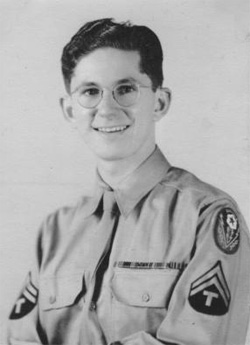
Photograph of Col. Joseph B. Sullivan. This image was taken in 1945 while Joseph served as a Technician 5th Grade with the 50th General Hospital.
Enlisted Personnel:
| Master Sergeants: | Privates First Class: |
| Bruschera, James J. (39089049) | Adams, Brant K. (39829657) |
| Adams, Herman S. (39829668) | |
| First Sergeants: | Adams, LeRoy W. (39829686) |
| Bechtold, Christian L. (6946368) | Allen, Bliss B. (37531530) |
| Anderson, Edward D. (14134117) | |
| Technical Sergeants: | Bach, Lysle M. (15306022) |
| Demchick, Emil J. (35318717) | Barton, Ralph L. (35723598) |
| Denny, Howard T. (19146660) | Bedwell, John D. (14131199) |
| Larson, Orlin R. (37269236) | Benson, Gordon E. (36476804) |
| Wall, James T. (11087741) | Berry, Warren W. (39695103) |
| Winn, Ralph C. (19049626) | Bicknell, John A. (35410869) |
| Wright, Coy B. (19013244) | Bidlock, Woodrow M. (34210538) |
| Blomstedt, Robert K. (31119885) | |
| Staff Sergeants: | Bohacik, John (NMI) Jr. (35579671) |
| Applebee, Gail L. (37204892) | Bonvjllian, Tuomas J. Jr. (35516899) |
| Ashley, Hobert E. (39396355) | Boxx, Troy C. (31139210) |
| Bortner, Raymond A. (35318970) | Brasher, Dorel H. (17075516) |
| Jackson, Charles A. (39192417) | Brockoff, Gerhard H. (37175167) |
| Lowe, Andrew J. (38150427) | Brown, Charlie (NMI) (31360611) |
| Lowe, Laurence E. (37157957) | Brown, George L. (31361958) |
| Newlin, Richard S. (35469024) | Brunski, Leonard J. (35383351) |
| Ronneberg, Robert L. (37178378) | Carithers, Willie F. (31351257) |
| Russell, Dallas B. (33194595) | Catlin, Paul R. (32731950) |
| Trodden, John S. (33155411) | Chalfin, Joel (32788819) |
| Christopher, Earl J. (30196698) | |
| Technicians Third Grade: | Clark, William E. (31335177) |
| Abbott, Charles G. (17003779) | Cole, Allen L. (36562688) |
| Baker, Laurence E. (37345981) | Davis, Jimmie D. (35165028) |
| Bullridge, Hugh L. (37145731) | Delgado, Nestor (NMI) (31213193) |
| Bareis, Robert C. (32140311) | Edmond, Orville A. (35111510) |
| Chelgren, Stanley V. (39079513) | Ferris, Edward P. (39201718) |
| Crinean, Thomas H. (19145153) | Fleming , David H. (31312111) |
| Duff, Alan (39846171) | Flippin, Hubert Li. (31312113) |
| Fuerstman, Sanders (32392108) | Foss, Orville G. (37178552) |
| Gilbertson, Glen L. (37177622) | Gidley, Samuel E. (31361371) |
| Lebens, Frederick A. (37177892) | Gilman, Ellis W. (37176103) |
| Mullen, Robert B. (19145154) | Gilson, Ira E. (31351119) |
| Ungermah, Augustus J. (32456856) | Gimmestad, Orville E. (37178671) |
| Wiltfang, Daniel H. (37113240) | Goodthunder, Francis G. (37173676) |
| Zolenka, Harry J. (37177788) | Gray, Lowell L. (31351153) |
| Guyer, Frank A. (33249143) | |
| Sergeants: | Hawley, Clarence L. (36599991) |
| Albrecht, Charles M. (36601635) | Hay, Karl H. (33219021) |
| Andersen, Raymond L. (36364032) | Hileman, Robert W. (36123103) |
| Biazavitch, Martin J. (31061421) | Hodge, Hazel L. (31129110) |
| Brandley, Gorman D. (37202169) | Holland, John P. (31213160) |
| Bresnahan, Charles E. (31061473) | Hyder, Roy (NMI) (31010119) |
| Brothers, Arthur E. (34663291) | Kennedy, Van W. (11105301) |
| Crawford, Albert A. (36196709) | Kimble, Keith K. (33206162) |
| Fach, Francis R. (35468547) | Knowles , Robert W. (35721101) |
| Goodnight, Lester G. (38157032) | Koch, David (NMI) (37138093) |
| Holfman, Walter J. (37175469) | Kulkman, Carl H. (32118028) |
| Hendin, Harold W. (36376567) | LaPlante, Joseph A. (31080861) |
| Herbert, LeRoy (NMI) (39007337) | Lombardi, Lannie (NMI) (31110818) |
| Isakson, LeRoy N. (37290416) | Lopez, Joe (NMI) (35386623) |
| Jemison, James D. (6904560) | Losinger, Leland (NMI) (36151259) |
| Mandrean, Costi Jr. (35319045) | Mallett, Herschel F. (18075601) |
| Nygaard, Randolph B. (37289298) | Maloney, Edward M. (12100389) |
| Rathe, Donald C. (37300878) | McCrillis, Robert B. (31157106) |
| Rogers, Bonnie J. (34129259) | McDonough, Patrick J. (32281889) |
| Russell, Hugh L. (34360740) | Mertz, Albert W. (35261313) |
| Simpson, Raymond L. (37449303) | Miles, Herbert A. (31172680) |
| Smith, Edwin K. (14134304) | Montagano, Diamante (NMI) (36362288) |
| Soeters, Lebertus J. (36458924) | Montalbano, Joseph J. (35110198) |
| Stephens, Charles A. (37331918) | Moon, Minuard E. (39156589) |
| Torres, Joaquin (NMI) (19049895) | Moraido, Alberto (NMI) (39698700) |
| Wilson, Eugene H. (3150453 ) | Nichols, Duane E. (37177517) |
| Perkins, James (NMI) (58388881) | Ohlin, Carl L. (35110213) |
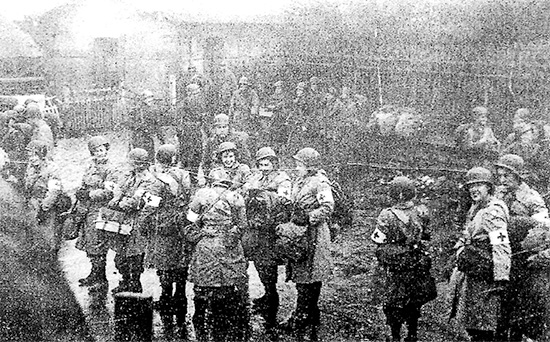
50th General Hospital Nurses ready for departure from Carentan (Normandy) to Commercy (Lorraine region), France. Photo taken around early November 1944.
| Technicians Fourth Grade: | Overbaugh, Edgar L. (35265911) |
| Abel, Joseph J. (37269944) | Patrick, Gardner (NMI) (31172915) |
| Abrams, Cyril E. (34128968) | Piacitelli, John (NMl) (11091387) |
| Arett, Edward J. (37548394) | Pranulis, Stanley A. (31311611) |
| Boggs, Ruben E. (37087758) | Pugh, Howard C. (36180325) |
| Bowen, Gerald C. (37330353) | Radle, Harold E. (37290136) |
| Brown, Hugh J. (36071259) | Riehm, Kenneth M. (35111517) |
| Canter, James E. Jr. (14134068) | Riffe, Charles R. (32728662) |
| Cash, Gordon F. (31159212) | Rothman, Alvin (NMI) (35110221) |
| Chadwick, George J. (37331641) | Saunders, Claude E. (37036330) |
| Coble, Grover C. (34312235) | Perli, Matt (NMI) (37036330) |
| De Long, George (32447692) | Savage, Leslie (NMI) (39235539) |
| Dyson, Devon W. (34311923) | Scarborough,William A (33231127) |
| Epstein, William E. (35314900) | Schirlinger, Magnus E. (37178207) |
| Frey, Lawrence P. (33057099) | Schlenker, Walter F. (17121882) |
| Giovanniello, Stephen V. (32422973) | Schrock, LeRoy D. (36592662) |
| Graf, Charles F. (16003598) | Shesko, Steve (NMI) (35313526) |
| Haley, Robert L. (39235401) | Silva, Vicente (NMI) (38033380) |
| Harry, David W. Jr. (33207897) | Simpson, John L. (34312114) |
| Haynes, Roger G. (35413373) | Smith, Chester (NMI) (12127038) |
| Helberg, John W. (32513818) | Smith, Linord H. (34335309) |
| Hinrichsen, John G. (32422923) | Smitherman, Joel T. (34344101) |
| Hittel, Louis (NLI) (31000955) | Sorvari, Bruno H. (37176986) |
| Howard, William F. (31159427) | Sowash, Douglas R. (35721156) |
| Hyche, Calvin L. (34335406) | Sowerby, John J. (33110359) |
| King, Hugh E. (34129776) | Spencer, John P. (31366765) |
| Koschke, Rudolf (NMI) (32269235) | Stephen, Vincent A. (37125704) |
| Lanza, John F. (34202127) | Stewart, James D. (36116553) |
| Larson, Maurice S. (37177884) | Stone, James R. (31360691) |
| Larson, Richard S. (17111015) | Sutton, Willian B. (35727363) |
| LaTondre, Clifford R. (37177503) | Taylor, Jack P. (38189008) |
| Lehmann, Clifton C. (32867758) | Thomas, Edgar P. (31169036) |
| Lewis, Floyd T. (35645488) | Thomas, Tony J. (39096759) |
| L’Huillier, Donald S. (12131431) | Thorpe, John E. (31360309) |
| Lucas, James W. (14105317) | Trout, Alex E. (37178193) |
| Mills, Roland R. (34312365) | True, Willard A. (39305161) |
| Mize, John T. (34311541) | Turner, Otis L. (31193322) |
| Mundy, James W. (34312555) | Valenzuela, Nofre (NMI) (39212931) |
| Naglosky, Joseph (NMI) (33350535) | Wickstrom, Adolph C. (37177791) |
| Nifong, Everett L. (34312285) | Wendorff, Clarence A. (37178121) |
| Oehrke, Haman F. (36239774) | Wilkerson, Frank R. (31351358) |
| Olson, Christ A. (37177537) | Will, Carl V. (37121523) |
| Pender, Thomas F. (31140887) | Williams, Oscar A. Jr. (31311691) |
| Perry, Peter (NMI) (32383943) | Williams, Porter B. (37181137) |
| Raleigh, Stanford F. (37422164) | Williams, Victor S. (35163251) |
| Rankin, Wayne E. (37332327) | Wilson, Harold L. (35661666) |
| Saunders, Horace B. (36510451) | Winkle, Raymond W. (37211773) |
| Schneider, Charles (35413269) | Wisnieski, Stanley J. (36180491) |
| Schneider, Eugene S. (32417953) | |
| Sloop, Jacob L. (34312199) | Privates: |
| Stocker, Oliver M. (37178108) | Agranoff, Jerome (NMI) (32397541) |
| Stubblefield, Alfred L. (34360697) | Aguilera, Raul (NMI) (38111610) |
| Swaney, Lester B. (14134071) | Ambrosi, August (NMI) (32809181) |
| Taylor, Ernest F. (34360642) | Anderson, Kenneth Earl (32731543) |
| Terrell, Arnold H. (34312539) | Ash, Elmer (NMI) (37371943) |
| Thompson, Clifton L. (19146551) | Bakken, Hjalmer C. (37270265) |
| Tong, Chin Q. (31158137) | Barker, Walter M. (31155573) |
| Uhl, Edwin W. Jr. (32447212) | Barnes, Commodore R. (36297173) |
| Wagner, Raymond R. (35468644) | Beaudoin, Leo L. (31219238) |
| Wallat, George H. (33330214) | Bickel, Robert B. (35719271) |
| Woodruff, Williaa A. Jr. (34381669) | Boggs, Gilmer B. (31312515) |
| Boykin, Johnnie F. (31663665) | |
| Corporals: | Brandt, Larry D. (37172312) |
| Baker, Commodore (NMI) Jr. (35546841) | Branning, Harold F. (35515777) |
| Barbour, John D. Jr. (34312082) | Brodsky, Ralph (NMI) (36605861) |
| Black, Eric H. (34361923) | Brooks, William M, (35535592) |
| Borden, Joseph W. (34335427) | Brown, Clarence D. (33377101) |
| Clements, William G. (34243141) | Burdeski, Henry W (37178569) |
| Dalla, George (NMI) (37454587) | Capaccio, John R. (35627275) |
| Douglas, John E. (3434623) | Carnes, Sam (NMI) Jr. (31129280) |
| Edwin, Howard E. (17107669) | Carper, Charles N. (35110571) |
| Hoffman, Ben (NMI) (35336809) | Carr, Hardie F. (31351128) |
| Hunter, John A. (32679677) | Clark, William H. (35443521) |
| Jensen, Chester T. (37178573) | Clodfelter, Thadus B. (34311529) |
| Johnson, Robert K. (37331653) | Coleman, Donald J. (37539065) |
| Joines, John E. (36312015) | Collins, Talmage M. (35768841) |
| Klein, Alvin J. (33296631) | Coniglio, Benny (NMI) (32605530) |
| Lorenzen, Eugene E. (17030239) | Corliss, Ralph D. (19116613) |
| Murphy, Victor W. (37178500) | Cornich, Steve F. (35531256) |
| Myerly, Oren R. (37217301) | Corcoran, J_mes B. (32186057) |
| Pietrzak, Henry J. (37177739) | Correll, William M. (31770631) |
| Sherwood, Henry L. (35313762) | Coyle, Joseph L. (31153260) |
| Uht, James M. (35666617) | Dearriba, Juan M. (32515676) |
| Williams, James C. (36665088) | Dewar, Tillman B. (31312606) |
| Yeager, Roy (NMI) (35635132) | DiSoiullo, John (NMI) (32719619) |
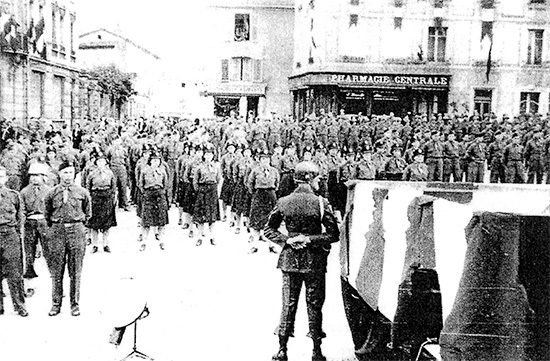
Partial view of VE-Day parade and review of the 50th General Hospital personnel in Commercy, France.
| Technicians Fifth Grade: | Doherty, John E. (31238759) |
| Abbott, Ernest R. (33299931) | Duerr, Albert H. (32035910) |
| Albright, Norman C. (35605653) | Duncan, George (NMI) (36161099) |
| Allred, Reggie C. (36313566) | Dupont, L.awrence G. (31373775) |
| Auman, George R. (36312007) | Dwornczek, Frank J. (36358302) |
| Barbour, William C. (36311973) | Elliott, John E. (36296655) |
| Barton, John A. (31167506) | Ellis, George E. (31159360) |
| Biggs, Raymond G. Jr. (32446432) | Ferguson, Frank H. (32952619) |
| Blunmenthal, William (NMI) (36357150) | Fletcher, Vernon G. (37192359) |
| Boudouris, Thomas (NMI) (32516673) | Ford, Max (NMI) (39829721) |
| Brazinsky, Joseph F. (31080666) | Forlines, Leonard L. (31312173) |
| Catuska, Donald W. (37157975) | Frank, Sidney E. (38207728) |
| Cessna, Glenn R. (37210678) | Frye, Sherrill H. (33125361) |
| Cherry, Robert E. (36335693) | Gasca, Porfirio L. (32919070) |
| Clark, Harry F. (32076689) | Gonzales, Jose S. (37353566) |
| Clifford, Ronald E. (37669586) | Gorder, Harold C. (36222936) |
| Cornelius, Allen R. Jr. (36361360) | Grombach, Paul Q. (33279529) |
| Crampton, John W. (33196596) | Harper, William C. (35111221) |
| Deal, Wiley F. (36356232) | Hart, Everett W. (32363666) |
| Deane, Matthew J. (31081688) | Herman, Elmer L. (33287511) |
| Dial, James H. (36312163) | Hill, James F. (31312331) |
| Dickeson, James H. (37192330) | Holden, Johnie V. (31361056) |
| DuBois, Frederick G. (35661331) | Holtsclaw, Thomas J. (37061379) |
| Duncan, William H. (37206688) | Hopp, Emery A. (37173572) |
| Firman, Walter P. (33671809) | Hutchison, Ray H. (31129611) |
| Fulk, Bernard L (35331155) | Ihly, Claud H (31381711) |
| Gavagan, Francis O. (35366661) | Johnson, Wesley A. (17050953) |
| Golon, Edward W. (36333255) | Kanner, Jerome J. (35066113) |
| Haim, Sol M. (32626632) | Kasper, Edwin W. (36072521) |
| Harris, Charles E. (35090925) | Kellum, Carson B. (31311329) |
| Harris, James W. Jr. (36312567) | Kimble, Hubert T. (35507098) |
| Havens, Robert L. (12206066) | Knost, Alvin T. (35161715) |
| Henke, Darwin A. (37176899) | Knowles, Gustus (NMI) (31110866) |
| Herndon, Francis W. (33128910) | Kosek, Willard J. (37177936) |
| Hertel, Otto A. (32667537) | Kosola, Toivo H. (37175539) |
| Hicks, Connie L. (36313693) | Kraynak, John G. (33056013) |
| Holt, Claude C. (39306312) | Lake, Dewey (NMI) (35794762) |
| Hopkins, Robert A. (32700587) | Lapool, Norris G. (35137005) |
| Jensen, John F. (37177562) | Lenehan, Joseph L. Jr. (12121287) |
| Jester, Oby (NMI) (37521666) | Light, William E. (17016350) |
| Jordan, Lewis M. (36616050) | Lippincott, Lyman L. (35627219) |
| Jurgens, Henning A. (32623036) | Lohrey, Wilbur H. (37516168) |
| King, Elmer L. (36100170) | Longo, Leonard W. (32838563) |
| Kite, Max L. (36601366) | Ludenia, Wilfred J. (37300879) |
| Kitt, Eugene E. (15107336) | Ludwig, Robert H. (13101575) |
| Klay, Reynold (NMI) (17067883) | Malbon, David R. (31081437) |
| Knopf, Raymond A. (37178675) | Markel, Joseph (NMI) Jr. (35319300) |
| Koecher, William H. (37175361) | Massengill, Nathan (NMI) (31379153) |
| Kowalski, Vincent (NMI) (31167672) | Massucci, Michael V. (32993738) |
| Kramer, Charles W. (33166715) | Mathews, Howard G. (37211589) |
| Ladner, Hubert F. (34349941) | Mato, Paul B. (35388500) |
| Layton, Kermit L. (34312199) | McGuire, William H. (31362990) |
| Lee, Jing (NMI) (35538700) | Mclnally, Aubrey E. (36852102) |
| Leopold, Edwin J. (37178570) | McKitterick, John E. Jr. (7032789 ) |
| Long, Eldon J. (35411368) | McMahon, Francis C. (31145155) |
| Luck, Chester A. (35316152) | Meyer, Howard A. Jr. (35361537) |
| Marchand, Ralph V. (35388307) | Middleton, James B. (31129856) |
| Martin, Herman L. (31362657) | Miller, Harold E. (33249050) |
| Mattson, Walter T. (37177710) | Moret, Nelson E. (32395717) |
| McCullough, Ray C. (37157991) | Murphy, Joseph B. (32608585) |
| McGregor, Joseph G. (33128169) | Mynott, Carl S. (34362189) |
| Mikols, Henry (NMI) (33128169) | Nimen, Robert P. (35601762) |
| Miller, Demetrio J . (39017059) | Nims, Boyclen M. (31129253) |
| Miller, Lyman D. (36253080) | Norris , Howard H. (31129760) |
| Moffitt, Cornelius Q. Jr. (31311635) | Olson, Herbert L. (37177997) |
| Montgomery, David L. (31150725) | Pascal, Charles J. (19112896) |
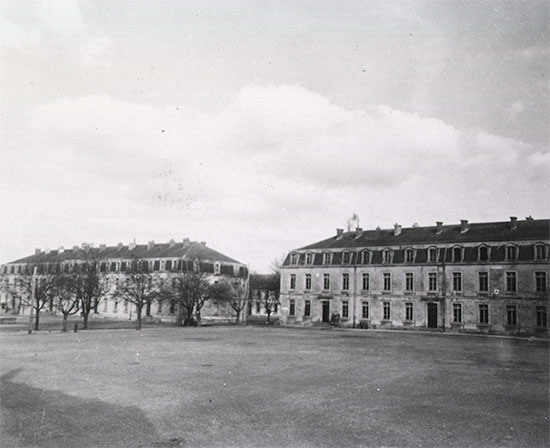
Buildings complex which housed the 50th General Hospital’s main wards during its stay at Commercy, France.
| Moser, Horace E. (34312272) | Patterson, Paul (NMI) (31.31251) |
| Olsen, Glen D. (39829599) | Pennell, John C. (19111521) |
| Palmer, Jake A. (31213332) | Perkins, Alex (NMI) (35265851) |
| Passero, Eugene R. (16117240) | Peterson, Elmer F. (36803909) |
| Payette, John B. Jr, (33208383) | Peterson, Howard E, (37195497) |
| Pritchard, Arthur (NMI) (34257785) | Petzke Arthur G. Jr. (36813798) |
| Purdy, John R. (35160561) | Poole, Alvin H. (31116752) |
| Rataiczak, Edward (NMI) (35318893) | Prevatt, Charlie G. (34505377) |
| Robison, Richard L. (15324027) | Quirk, Robert E. (36339301) |
| Rushton, Verdie B. (34343777) | Reyes, Leonardo (NMI) (33355197) |
| Scarpulla,, Louis (NMI) (33207323) | Rice, Lester (NMI) (34354087) |
| Scherle, Fred (NMI) (6577896) | Rossetti, Robert (MMI) (35601761) |
| Schnegg, George P. (35033314) | Sansom, Oree (NMI) (31335175) |
| Severson, Albert H, (37178363) | Schaeffer, George W. (R-224921) |
| Seybold, Delbert F. (36410351) | Schley, Alvin L. (19116612) |
| Simpson, Hubert L. (37189961) | Schuatte, Ewald R. (37178156) |
| Stockamp, Charles G. (37179934) | Short, Lloyd M. (31361511) |
| Stoyer, Reymer L. (33237989) | Skernivitz, John S. (35531088) |
| Sublett, Norbert W. (35485112) | Smith, Earl E. (31686370) |
| Sullivan, Joseph B. (39208186) | Spivey, William W. (31360686) |
| Sweeney, John. D. (33326827) | Stadwick, Carl A. (37173192) |
| Tandaric, Nickolas J. (33279441) | Stahlmann, Otto A. (37181177) |
| Thomas , Charles J. (34129030) | Stallings, Carlton L. (31311767) |
| Thomason, John S. Jr. (34361533) | Stathem, Glenn R. (39211552) |
| Treneczynski, Joseph (NMI) (36328265) | Sunley, Norman L. (36011123) |
| Van Veghten, Robert L. (32138788) | Taggart, John P. (33325650) |
| Waits, Denzil W.. (36355283) | Tarasoff, Mike E. (39076391) |
| Watson, Robert R. (31360900) | Tarvor, Norman L. (31801007) |
| Whitt, George C. (35187291) | Tashgy, Robert C. (12089029) |
| Wilcox, Robert. H. (37160814) | Thede, Roger J. (17085791) |
| Willard, Stewart L. (14137306) | Thomas, Cornis A. (31335191) |
| Wilson, John L. (17033500) | Thompson, Robert J. (31360757) |
| Wiltse, Willard A. (37198129) | Umbarger, Emmett L. (31360710) |
| Yasko, Stephen J. (36362402) | Weiker, Clayton V. (35551990) |
| Zak, Hencl A. (37178131) | Wells, Thomas J. (11131207) |
| Zander, Raymond J. (36331178) | Whidby, William T. (31351169) |
| White, Reginald O. (17050917) | |
| Willis, Cadez (NMI) (34363341) | |
| Wilson, Charles A. (37178119) | |
| Wolanin, Thaddeus L. (33570780) | |
| Yankovich, Joseph R. (35531055) | |
| Zeppi, Gene P. (31167539) | |
| Zerra, Genere (NMI) (31128081) |
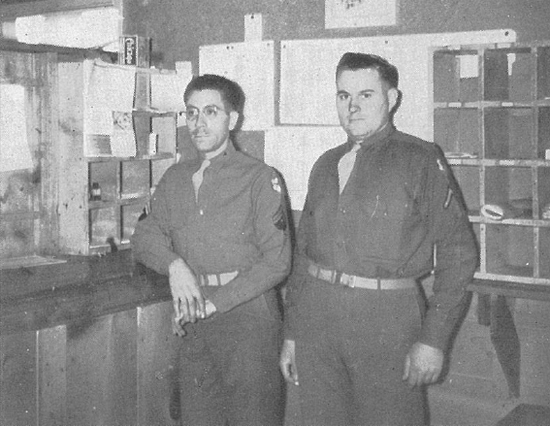
T/4 John F. Lanza and Pfc Kenneth M. Riehm in the Hospital’s Post Room and Post Exchange.
The authors would like to thank Colonel Joseph B. Sullivan who served as a Technician 5th Grade with the 50th General Hospital during WW2 (ASN: 39208186). Col. Sullivan kindly shared most of the documentation and material needed to put together this Unit History.
